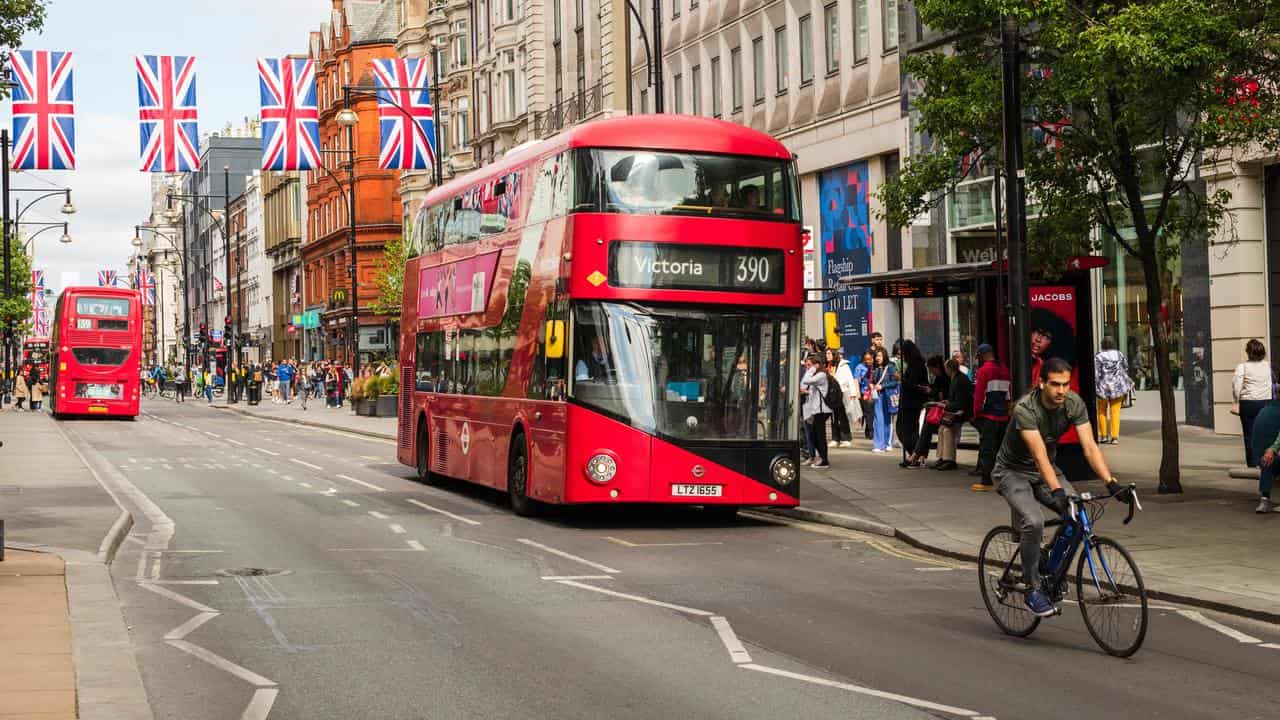
Strolling down busy Regent Street, crowds spilling over footpaths, cyclists whizzing by and coronation Union Jack flags flapping overhead, the buzz of rush-hour traffic is electric.
And that’s to say it is virtually silent.
Even London’s iconic, red, double-decker buses, powered by batteries and hydrogen, make very little noise in the world city that is now being hailed as a trailblazer for eco-friendly transport.
While Australian policymakers mull over whether to ban new petrol car sales in 2035, this city is already discouraging many of them from being driven in urban areas.
And while Uber this week launched its electric vehicle service in Australia, with a goal to remove fossil fuel cars from its platform by 2040, the company plans to achieve the same thing in London 15 years earlier.
The city’s progress is the reason Uber chose London to announce new green software and commitments this week.
And experts say Australia can learn lessons from London on how to accelerate its move to electric transport.
The rideshare giant announced several changes to its platform at its Go-Get Zero event, including a commitment to make Uber Eats deliveries electric by 2040 and to eliminate plastic packaging by 2030.
Other changes include fuel-efficient maps and “battery-aware matching” that delivers electric vehicle drivers jobs based on their car’s level of power and recommends when and where to recharge.
Uber chief executive Dara Khosrowshahi says the company’s experience in the UK capital, where nearly one in every five miles covered by an Uber takes place in an electric vehicle, has provided guidance for what it and governments can do to accelerate the transition.
“World-leading policies in London and the UK to lower emissions and clean up transportation have had a significant impact,” he said.
“Our experience in London has set the stage for us now to begin to scale electrification on a global basis.”
Unlike Australia, the UK has rapidly embraced electric vehicles which now account for 16.9 per cent of new car registrations – more than double Australia’s May rate of 7.9 per cent.
Electric vehicles are even more popular in its capital, where the next-generation cars represented one in four new vehicles registered in 2022 and where the streets are populated by models from VW, MG, Audi and Renault that have yet to make it to Australia.
One of the driving forces behind the city’s transformation, Uber sustainability global lead Chris Hook says, is local and national government policies.
The UK announced a plan to ban petrol and diesel-powered cars in 2030 three years ago and will phase out hybrid vehicle sales by 2035 – a move that is tougher than the toughest Australian state or territory target.
The city of London also introduced low-emission and ultra low-emission zones where drivers with older, more polluting vehicles must pay a daily $23 charge to use the roads.
Its ultra low-emission zone will expand in August this year to cover all parts of Greater London.
Mr Hook says the policies have played a major role in getting more electric vehicles on London streets but the same approach could not simply be “copy-and-pasted” to guarantee success in other parts of the world.
“It would be a mistake to say this is working here so this will work everywhere,” he said.
“Policies have got to be localised, they have to make sense in terms of that city or country.”
Australia’s commitment to introducing a fuel-efficiency standard to boost electric vehicle supply and competition should make a significant impact on its market, for example, he says.
Changes to the fringe benefits tax on electric vehicles and more generous incentive schemes, Mr Hook says, are also boosting the number of electric vehicles in Australia.
Their numbers grew enough for the tech company to launch its Uber Green service allowing riders to request an electric or hybrid vehicle this week – an addition Mr Hook says “wouldn’t have been a good customer experience” just one year ago.
“We've got five times more EVs today than we had a year ago in Australia,” he said.
“I'm expecting to see that number grow a lot in the next year and launching Uber Green feels like a step in the right direction.”
Changes to Uber’s software to support electric vehicle drivers may take longer to launch in Australia, with many being tested in more advanced markets, but Uber product management vice-president Sachin Kansal says the additions could address concerns about buying an EV when they are ready for a wide launch.
Some professional drivers, he says, have legitimate concerns about elements of switching their petrol car for an electric vehicle and addressing them will take time.
“All the concerns that we've heard from drivers, including cost, including charging, lack of familiarity, that’s real,” he said.
“We think that it is our responsibility to try and solve that problem for them and provide education, to provide the cost comparison, then to provide an ability to rent or buy.
“We feel the transition is never happening quick enough.”
The reporter travelled to London as a guest of Uber.









